�

�
The 3.5-Litre Morgan Plus-8
�A True but Primitive Sports Car
��
as published in British V8 Magazine, Volume XVI Issue 1, May 2008�
�
Re-printed unedited by exclusive written permission of "Motor Sport".
�
This article originally appeared in their December 1968 issue.
�
New photos by Curtis Jacobson and Greg Myer have been added.
�
125 m.p.h. A standing-start 1/4-mile in 15 sec.
��
Sports cars come and sports cars go but the Morgan has outlived most of them. Just when �
it seems to have out-dated itself from even the American fanatical and British enthusiast �
sales-charts, something happens to give the Morgan four-wheeler, basically unchanged down �
the years, a new lease on life, sustaining the interest of prospective purchasers. �
�
The original Morgan four-wheeler was an attractive little car, but it lacked the flair �
and sporting appearance of the similar-size MG's, which in those days had wire wheels �
and a trials reputation, against which the Morgan 4/4 had to compete. Pressed-steel �
wheels and a chassis rather self-consciously aware that it was closely related to a long �
generation of three-wheelers. But it had independent front suspension and a gear lever �
most commendably located, due to the employment of a separate gearbox. The 4/4 ran through �
a succession of engines, and then came the exciting news that a Morgan Plus-4, with a �
2-litre engine, was on the assembly-shop floor at Malvern. �
�
The Plus-4 chassis was a somewhat inflated version of that used for the 4/4, strengthened �
only where the ingenious Mr. Peter Morgan thought this absolutely essential. It had the�
appearance and performance of a good vintage or p.v.t. sporting car, and when, later, it �
was powered with warmed-up 2.2-litre Triumph TR4A engines instead of a single-carburetter �
Standard Vanguard engine, it really motored most effectively, and was impressive on the �
Club circuits. That, however, was quite a long time ago and the Plus-4 clearly needed a �
new lease of life. This has been most effectively accomplished by installing under a�
somewhat lengthened bonnet (still heavily louvered) a perfectly normal Rover V8 engine, �
of Buick persuasion, as used by the Rover Company in their 3.5-litre cars. The potential �
of these light-alloy General Motors - Oldsmobile and Buick power units was emphasized �
by racing development, from mild souping for stock-car work to virtual rebuilding for �
installation in the Formula One Repco Brabhams, so it can be said to have links with racing �
if not to be actually race developed. It gives 161 (net) b.h.p. at a crankshaft speed of �
5,2000 r.p.m. This is on a c.r. of 10.5 to 1, so that 101-octane petrol is preferable but �
not essential if only Premium is available. The engine is absolutely standard, as used in �
the Rover 3500, even to very ordinary exhaust manifolds, and there should be plenty of �
development to come. �
�
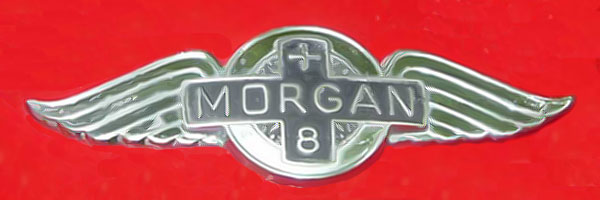 �
�
� Using the splendid Rover V8 engine so ably adapted to Solihull specification by Peter Wilks � has lifted the performance of this Morgan sports two-seater from effective to highly� impressive. That is to say, this primitive, certainly old-fashioned, car will now reach � a top speed of 125 m.p.h., will devour a s.s. 1/4 mile in 15.0 sec. or less, and will � out-accelerate a Jaguar E-type up to the legal limit of public road speed in this go-slow � country. It continues to accelerate excitingly beyond 70 m.p.h. (on private roads, of course!) � For having got to that pace in well under 9 sec., it requires only another ten seconds � to be motoring at 100 m.p.h. This, with a bog-standard 89 x 71 mm. (3,530 c.c.) Rover engine.� It is fascinating to think how the Morgan Plus-8 will go when fuel-injection or other � performance-enhancers are tried - and I expect one or other of the Peters will experiment � with them. �
��
Right away, therefore, it seems obvious that if sheer performance, in terms especially of �
acceleration and a reasonable top speed, appeals - straight-line go, if you like - the �
Morgan Plus-8 is a formidable motor-car, because it offers this in terms which only �
very few cars, costing more, can equal. Take for instance 0 to 100 m.p.h. in 19 to 20 sec.,�
for a price, including p.t., of £1,487. Those interested in Marque Sports Car Racing�
should be interested... �
�
Returning to the differences between the Triumph-powered Plus-4 and the new Plus-8, they are �
quite few in number. For instance, the separate gearbox is retained, coupled to the engine �
flywheel by a short shaft within a large-diameter tube, and it is the same Moss gearbox used �
on the Morgan Plus-4 and earlier Jaguars, this apparently being sufficiently rugged to transmit �
the 226 lb./ft. maximum torque of the Rover engine. The real separate chassis is also retained, �
although it has been somewhat strengthened. The old wood plank floor - I was intrigued that it �
was not so much as creosoted - has given place to a welded-steel floor. The coil-spring and �
pillar i.f.s., which is basically nearly 60 years old, remains, and still necessitates a bronze �
damper-ring and lubrication bled off the engine supply, for the pillars also form the king-pins �
of the steering layout. Similarly, at the back the suspension is by 1/2 elliptic leaf springs, �
although these are now mounted at a different angle, which has killed tramp, and the movement �
has been increased, to 4.5 in. The steering column now incorporates two universal joints to �
clear the wide vee engine, is collapsible, and the box is a Cam Gears' cam-and-peg unit.�
�
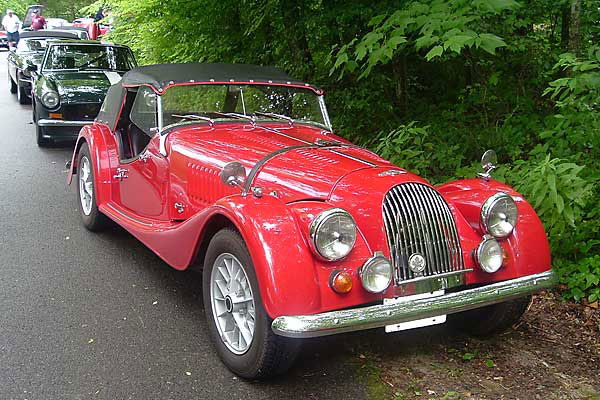
�
Paul Foster's stunning Morgan Plus-8, photographed at British V8 2006 in Townsend TN�
�
The wheelbase has been increased by 2 in., the bonnet is longer, and the body 2 in. wider to �
accommodate wider wheel rims. The wheels have been changed to imposing Robinson five-stud �
cast-alloy ones, the same make as those on the Gilbern Genie featured last month, having�
5.5 in. rims shod with imposing looking 185 x 15VR Dunlop SP Sport radial-ply Aquajet-tread �
tyres. A further concession to the increased and spectacular performance is the use of 16P �
Girling brake calipers instead of 14P, although the disc/drum sizes are unchanged. There is �
now a 13.5 gallon fuel tank and instrumentation and details have been changed. For instance, �
for years there was no adjustment, either of cushion or squab, for the bench front seat of the �
Plus-4. The Plus-8 has sliding Restall bucket seats upholstered in Ambla leathercloth - a �
revolutionary mod, for the Malvern market!�
�
The Rover V8 engine installation has necessitated a Woods-Jeffreys thermostatically-controlled �
electric fan, and the Salisbury back axle has a limited-slip differential and a ratio of �
3.58:1. The 90 degree engine goes snugly under the traditional Morgan bonnet with just a slight �
flattening of the air-cleaner for the two HS6 SU carburetters. Naturally, the clutch (a 9.5 in. �
diameter Borg & Beck), flywheel and starter are special to the Plus-8 - it seems that Rover �
may use these components if and when they bring out a manual gearbox version of their 3500. �
�
Because the engine is not supplied to the Morgan Motor Company - actually they go to Solihull �
and collect 15 a month - without exhaust anti-pollution the Plus-8 is not yet an export �
proposition to America, although it has press-button switches for safety, to comply with �
that aspect of the U.S.A. safety requirements which are costing such a lot of money to �
incorporate, and which are restrictive to small-output concerns.�
�
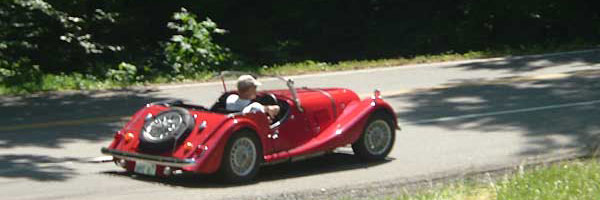 �
�
�
Driving the Morgan Plus-8�
�
Apart from its very satisfying measurable performance, 100 m.p.h. possible on quite short straights, �
so quickly and unobtrusively that only radar would notice it, as emphasised by the previously-quoted �
figures, the truly striking aspect of the Morgan Plus-8's running is the enormous torque delivered �
by the engine. Maximum torque is delivered at 3,000 r.p.m. and reaches 210 lb./ft. at 2,700 r.p.m.,�
but the car pulls very smoothly away from a mere 1,000 r.p.m. in top gear, and before 2,000 r.p.m. is �
reached things are very definitely starting to happen! This makes the Morgan as docile and one-gear �
as any big American sedan! Yet, using the gears, the acceleration is sizzling. The engine runs �
safely to 5,000 r.p.m. and can be pushed for short periods toward 6,000 r.p.m. Without taking the �
needle quite to the end of the tachometer scale, this means, apart from bullet-like take-off, maxima �
in the gears of 40, 70, and just over 100 m.p.h. Running at 30 m.p.h. in towns the Morgan's engine �
idles over at 1,400 r.p.m. in top gear. It is possible to accelerate away without making use of �
the harsh and notchy gear change, and at 70 m.p.h. the engine will be turning over at less than �
3,200 r.p.m. Even so, a higher axle ratio could be used with advantage, although it is, cruising �
at 100 m.p.h. on the Continent, the Rover V8 is running within 400 r.p.m. of the beginning of the �
red-sector on the tachometer. �
�
The gear change is by a splendid little central lever just forward of the facia. It is all too �
easy to brutally over-ride the synchromesh, which doesn't exist on bottom gear anyway, but �
enthusiastic drivers are unlikely to complain unduly! Reverse is selected by lifting the rigid little �
lever beyond the first-gear location. The clutch is very heavy, but not unduly fierce. The gear �
lever protrudes directly from the Moss gearbox, out of the transmission tunnel. Ahead of it, rather �
far forward on the left of the tunnel, though an average height driver sitting close to the steering �
wheel had no complaints, is the handbrake - and full marks, for it is the good old true fly-off type. �
It failed to hold the car only on the steepest gradients.�
�
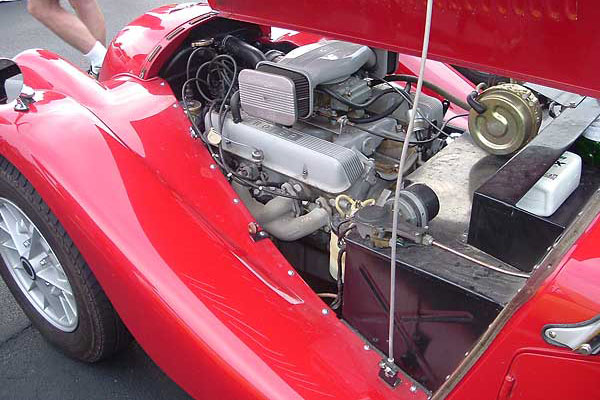
�
Morgan Plus-8 All-Alloy Vee-Eight Engine (note: this carb and air cleaner aren't original equipment.)�
� The Morgan Plus-8 is steered by a 14.5 in. dia. wheel mounted very close to the facia, so that one � tends to adopt a cranked-arms driving stance. It is an Astrali wheel with three drilled spokes and a � thick rim covered with a laced-up leather glove. The steering is heavy for parking, the huge tyres � dragging, dead in feel, a bit jerky in action, and not a lot lighter for sudden changes in direction, � although in sober town driving it feels light. There is only very mild castor return, and kick-back � is less evident than "fight" over bad surfaces, accentuated by scuttle shake. This is not particularly � nice steering, but, at 2.4 turns, lock-to-lock, it is quick and accurate. The big tyres have resulted � in a restricted turning circle. The steering pivots require lubrication every day, or every 200 miles, � a matter of conscience - which is achieved by prodding a high-set floor button, like a dip switch. This� is hard to press but seems to momentarily drop engine oil pressure by no more than about 10 lb./sq.in.� when the lubricant is hot. But it is a crude, messy arrangement and one hopes the strip-steel connections � between bronze damper ring and the frame last longer than they used to do, especially as the well-valanced � front wings now hide them completely, making inspection impossible and replacement unthinkable.�
��
Enjoying this article? Our magazine is funded through the generous support of readers like you!
�
To contribute to our operating budget, please click here and follow the instructions.
�
(Suggested contribution is twenty bucks per year. Feel free to give more!)�
�
The ride? Those concerned with modern suspension systems would no doubt cry from anguish or mirth, �
if driven fast over rough roads in the Plus-8. On really bad going the car seems to have no springs. �
In less bad roads it just jumps around and rattles. On main roads it floats along nicely. Trying hard�
on Welsh mountain passes the Morgan felt less safe than the Gilbern and I would think that a competition �
driver would lose time when the back-end bounced upwards and sideways and by the front-end suddenly �
going softish. On the other hand, I regard the Morgan as supremely good fun and very safe, to drive round �
a race circuit and certainly in ordinary fast road motoring the Dunlop SP Sports refused to breakaway �
or to protest. The Morgan rides and corners - like a Morgan. Which infers hard springing, negative roll,�
some understeer. The limited-slip differential and those excellent Dunlops permit lots of throttle �
to be used out of corners, even on wet roads. Yet although rear-end breakaway is not normal, a dab �
of throttle helps to balance the cornering by combating the understeer. Over the Abergwesyn-Tregaron�
mountain road the sheer power of the Plus-8 makes this difficult terrain seem tame, except that the very �
long bonnet, which itself is 4 ft. 2 in. long) masks the road on up gradients; there is the sensation, �
also associated with long-snouted pre-war cars, of sitting well back and having to steer the bonnet �
round the bends.�
�
The screen now has triple wiper blades but it no longer folds flat. Visibility is good, in as much �
as the n/s side lamp and part of the o/s headlamp cowl and vintage-type wing can be seen from the �
rather low driving seat by the average driver. Naturally, with its hood up things are less pleasant - �
but who wants to motor in a closed Plus-8 anyway? Especially as the hood's "lift-the-dot" fasteners �
required very strong fingers, or assistance from a coin or even a screwdriver, to budge them.�
�
The brakes, which have a Girling vacuum servo, are powerful and seem free from fade. Oil pressure �
is normally approximately 50 lb./sq.in.�
�
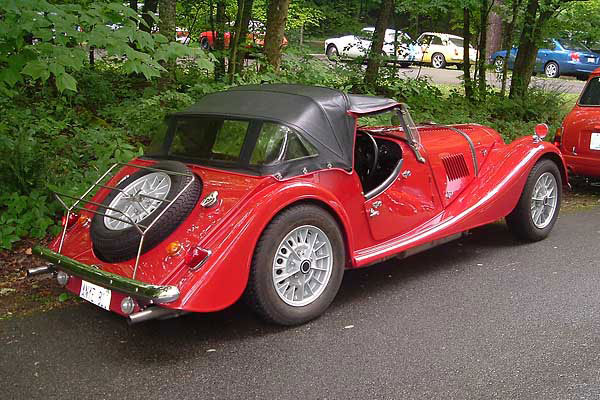 �
�
�
Reverting to the Plus-8 on the road, the engine gives a subdued vee-eight exhaust beat (although �
I was disappointed to find only a single tail-pipe) and is otherwise practically inaudible,�
although the lower gears howl. The heater wafts plenty of really warm air about, so that hood-down �
driving is no hardship. The Morgan looks low-hung but didn't bottom over rock-strewn surfaces. �
The centre-hinged bonnet opened easily on the o/s, but one of the two press-down catches on the �
n/s panel was very stiff. The present output of this intriguing Plus-8 is two a week, but the intention �
is to increase this to about five a week by 1969.�
�
The fuel tank has twin quick-action fillers and holds 13.5 gallons, giving a range of at least �
250 miles in ordinary conditions. Indeed, on mostly main road driving. I recorded 23.6 m.p.g. The �
intention had been to do a further check, motoring fast over a familiar Welsh mountain road, but �
in this I was hampered, and had to abandon the idea, because ponies were being taken over it to �
the November pony sales at Tregaron. Driven hard, consumption would no doubt fail to around 20 m.p.g. �
The only fault which developed during a three-day test, apart from the difficulty at times of �
opening the doors (chassis flexion?) was failure of the o/s sidelamp, which responded to the �
time-honoured thumping on the first occasion but not thereafter. Driving this truly exhilarating �
car with the hood down, in distinctly cold and wet November weather, to gain the enjoyment and �
benefit of fresh air, I was disappointed to notice a trace of exhaust fumes in the cockpit. These �
are probably sucked forward by the the aerodynamics of the tail, and no doubt will be experimented �
with to cure this annoying shortcoming. With the rigid sidescreens erect draughts are successfully �
excluded and open-air driving is otherwise a joy. �
�
The Morgan Plus-8 is a true sports car, and a very quick one at that. It weights around 21 cwt. �
laden, with some 160 b.h.p. to propel it. As I drove it, sighting along the louvered bonnet, �
air playing around by head, the smell of hot mud coming from the exhaust and that vee-eight �
wuffle from behind, nostalgia for the days of pre-war trials, of exploring good country in �
exciting cars, and memories of V8 and V12 Allards come crowding back. For that alone, I was �
grateful to this all-yellow Morgan. Regarded purely as a 1968 automobile, the Morgan may be �
something of a joke. But as a fun and fresh-air car perhaps the only thing comparable (even �
preferable) to a Plus-8 would be a 30/98. [British V8 editor's note: the Vauxhall 30/98 model was a�
legendary and exceptionally versatile car from the early days of motorsport. Only 600 were built �
between 1913 though 1927.] And a brand-new Morgan costs only £1,487 including p.t. and seat belts.�
�
-W.B.�
�
� Photos by Curtis Jacobson and Greg Myer. All rights reserved.�
�
